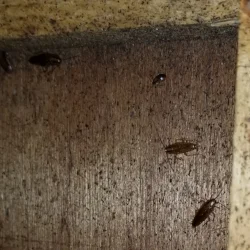German Roaches
The Who, What, Where, Why, and How
There are over 4,500 different species of cockroaches found throughout the world, but the German Roach is the one that strikes the most fear in the hearts and minds of home and business owners alike. The German Roach is the most difficult species to gain control over for many different reasons, and we will discuss some of those reasons during this blog. I hope after reading this blog that you will have a greater understanding about the characteristics of the German roach along with how to prevent and eliminate these creatures from you home and business.
What exactly are German Roaches?
Biology/Life cycle
The adult German Roach is ½ to 5/8 of an inch long that is light brown to tan in color. It has almost parallel stripes located on their backs, just behind their heads. They go through a gradual metamorphosis that has normally 6 nymphal stages. The stage between each molt is called an instar. This process usually takes around 60 days. They are prolific breeders as well. The female roach will carry the egg (ootheca) all the way up to hatching and each egg will house between 30-40 offspring and will produce 4-6 egg capsules during their lifespan. Their lifespan usually lasts between 100-200 days under ideal circumstances.
Where do German Roaches stay?
Habits/Habitats
German Roaches are not picky eaters. They are omnivorous and will practically feed on anything that is available. They are attracted to meats, anything starchy, sugars, and fatty foods. When those food sources are not available, they will feed on household items like soap, glue, and even toothpaste. Although German Roaches can be found almost anywhere in a home or restaurant, the most common areas where infestations are found is the kitchen and bathrooms. They are more commonly found in these areas due to the sources of food, water, and harborage areas these places provide. For example, in the kitchen you will find higher concentration of populations found in and around the oven, dishwasher, microwave, and refrigerator. These pesky creatures can enter a home by grocery bags, cardboard boxes, from a neighbor’s house, and most commonly used appliances.
Why are German Roaches dangerous?
Threats They May Pose
Besides just being a contaminator of our food supplies, German Roaches also carry a very high health risk. They are known to carry many different types of bacteria, parasitic worms, and human pathogens. When they walk through dead and decaying material, they pick up these bacteria and transfer it to food sources and anything they may climb on and through. They also possess many allergens that cause different types of allergic reactions and sicknesses including asthma. One of the largest contributors of childhood asthma is roach allergens and feces. They are a threat to the health and economic stability in a home and business.
How to get rid of German Roaches?
Preventative Measures (Things you can do)
One of the greatest ways to prevent a German Roach infestation is to make sure that you practice good sanitation throughout your home and business. An ounce of prevention is worth a pound of cure. Another important aspect of preventative care is to make sure you seal up all cracks and holes. Roaches love to hide in small cracks because they feel safe in tight places. Sealing up these places will eliminate harborage areas for them to live and breed. Places that you could seal up would be: countertops, baseboards, and all plumbing accesses. German Roaches can live months without food, however they can’t go a week without water. It would be advantageous to fix all water leaks, and not to allow any water to stand in the kitchen sink.
Eliminating an Active Infestation
The first thing that you will need to do to properly eliminate an infestation of German Roaches is to do a thorough inspection of infected areas. A thorough inspection will give you clues to harborage areas as well as areas that need to be sealed up. The next thing that would assist in elimination would be using a hepa-filtered vacuum to extract as many live roaches without the use of pesticides. Baiting all harborage areas will provide the roaches with a food source that will cause them to die and become sterile if the bait source has an IGR in it. An IGR prohibits nymphal roaches from molting into adults that can reproduce. A residual liquid insecticide can be applied to provide long term control as well.
Who do I call to solve my German Roach problem?
Contact Us
I hope this information has helped you! We would love to help you with anything pest related. You can reach us at 205-306-1959 or 205-587-7348 or email us your questions at john@superiorpestal.com or ben@superiorpestal.com. We look forward to hearing from you soon!!!


